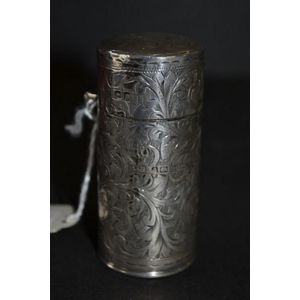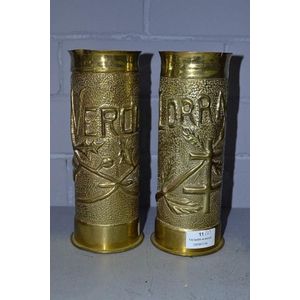17th Century Nepalese Copper Linga Cover with Shiva Faces
A Nepalese repousse copper linga cover, circa 17th century, the slightly domed cylinder is mounted with four faces of Shiva showing considerable traces of gilding, the front a fierce, bearded and mustachioed visage, the flared base of the cover rests on the coils of the naga-snake whose cobra head rises along the shaft, while the tail tucks neatly behind it's body, raised on a lotus base, 30 cm high. Provenance: Christie's Amsterdam, 'The Kemper Collection of Himalayan Art', October 1994, lot 58
You must be a subscriber, and be logged in to view price and dealer details.
Subscribe Now to view actual auction price for this item
When you subscribe, you have the option of setting the currency in which to display prices to $Au, $US, $NZ or Stg.
This item has been sold, and the description, image and price are for reference purposes only.
- Circa - A Latin term meaning 'about', often used in the antique trade to give an approximate date for the piece, usually considered to be five years on either side of the circa year. Thus, circa 1900 means the piece was made about 1900, probably between 1895 and 1905. The expression is sometimes abbreviated to c.1900.
- Gilding - Gilding is a method of ornamentation whereby a thin sheet of gold metal is applied to items made of wood, leather, ceramics, glass and silver for decorative purposes.
For furniture including mirrors, the sheet of gold is usually applied over a coating of gesso. Gesso is a mixture of plaster of Paris and gypsum mixed with water and then applied to the carved wooden frames of mirrors and picture frames as a base for applying the gold leaf. After numerous coats of gesso have been applied, allowed to dry and then sanded a coat of "bole", a usually red coloured mixture of clay and glue is brushed on and allowed to dry, after which the gold leaf is applied. Over time parts of the gilding will rub off so the base colour can be seen. In water gilding, this was generally a blue colour, while in oil gilding, the under layer was often yellow. In Victorian times, gilders frequently used red as a pigment beneath the gold leaf.
Metal was often gilded by a process known as fire gilding. Gold mixed with mercury was applied and heated, causing the mercury to evaporate, the long-term effect of which was to kill or disable the craftsman or woman from mercury poisoning. The pursuit of beauty has claimed many victims, not the least of which were the artists who made those pieces so highly sought after today. - Embossed / Repousse - Embossing, also known as repousse, is the technique of decorating metal with raised designs, by pressing or beating out the design from the reverse side of the object.It is the opposite of chasing, where the decoration is applied from the front. An embossed or repoussed object may have chasing applied to finish off the design.
Visually similar items

South East Asia lidded silver box
Sold by
in
for
You can display prices in $Au, $US, $NZ or Stg.

A Victorian silver sugar caster, of cylindrical shape, wrythen fluted and foliate embossed. Birmingham 1886 by S. Blackensee & Son. 66gms
Sold by
in
for
You can display prices in $Au, $US, $NZ or Stg.

Sterling silver scent bottle, Birmingham 1911
Sold by
in
for
You can display prices in $Au, $US, $NZ or Stg.

Pair of World War I French trench art brass vases, one with Verdun and the other Lorraine, each approx 23 cm high (2)
Sold by
in
for
You can display prices in $Au, $US, $NZ or Stg.
